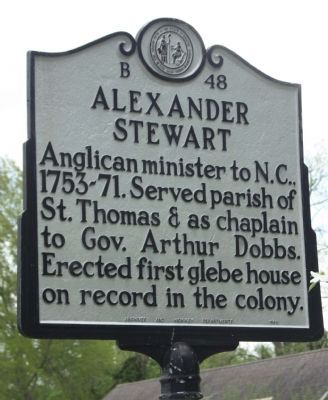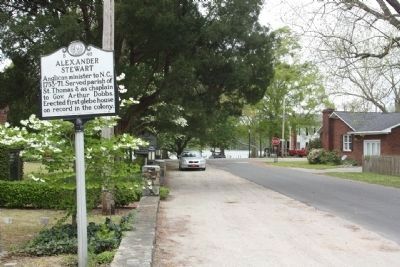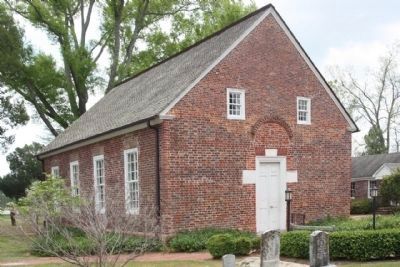Bath in Beaufort County, North Carolina — The American South (South Atlantic)
Alexander Stewart
Inscription.
Anglican minister to N.C., 1753-71. Served parish of St. Thomas & as chaplain to Gov. Arthur Dobbs. Erected first glebe house on record in the colony.
Erected 1968 by Archives and Highway Departments. (Marker Number B-48.)
Topics and series. This historical marker is listed in these topic lists: Churches & Religion • Colonial Era. In addition, it is included in the North Carolina Division of Archives and History series list.
Location. 35° 28.455′ N, 76° 48.797′ W. Marker is in Bath, North Carolina, in Beaufort County. Marker is on Craven Street near South Main Street, on the right when traveling east. Touch for map. Marker is in this post office area: Bath NC 27808, United States of America. Touch for directions.
Other nearby markers. At least 8 other markers are within walking distance of this marker. John Garzia (a few steps from this marker); St. Thomas Church (within shouting distance of this marker); John F. Tompkins (within shouting distance of this marker); First Post Road (about 600 feet away, measured in a direct line); Edward Teach (approx. 0.2 miles away); First Public Library (approx. 0.2 miles away); Palmer-Marsh House (approx. 0.2 miles away); James Adams Floating Theatre (approx. 0.2 miles away). Touch for a list and map of all markers in Bath.
Regarding Alexander Stewart. As chaplain to Royal Gov. Arthur Dobbs, Alexander Stewart (1723-1771) had hoped, on his arrival in America in 1753, to serve as an Anglican minister in New Bern. That post being filled, he made his way to Bath and to St. Thomas Church. He continued on the rolls of the Society for the Propagation of the Gospel. Stewart, born in Lisburn in County Antrim in Ireland, studied at the University of Dublin and served Irish parishes until his move to North Carolina.
During the course of his ministry, under his direction, the glebe house and attendant outbuildings were completed. The house was the first of its kind in the colony and rested on 300 acres of church-owned land on the outskirts of the town. He initially lived in the house, completed in 1763, but after two years acquired his own plantation on the south side of the Pamlico River across from Bath. From that point the glebe house was only for ceremonial use. James Davis, printer at New Bern, in 1758 published a tract by Stewart entitled The Validity of Infant Baptism. Stewart, in addition to his church work, was also superintendent of schools for Indians and Negroes in North Carolina, being appointed to that task by Dr. Bray’s Associates, an English benevolent society. That group in 1763 established a school in the Lake Mattamuskeet area of Hyde County for the Indians in that vicinity. That work paid fifty pounds
per year.
Stewart was persistently poor. As a result of a hurricane in 1769, he received injuries from which he died in 1771. His plantation was damaged severely by the storm and his estate was left in a state of confusion. (North Carolina Office of Archives & History — Department of Cultural Resources)
Credits. This page was last revised on June 22, 2021. It was originally submitted on June 2, 2013, by Mike Stroud of Bluffton, South Carolina. This page has been viewed 1,113 times since then and 20 times this year. Photos: 1, 2, 3. submitted on June 2, 2013, by Mike Stroud of Bluffton, South Carolina.


